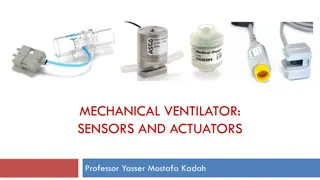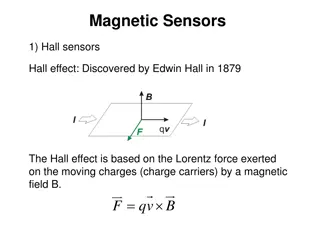Understanding Sensors in Biomedical Applications
Explore the world of sensors in biomedical applications with insights on transducers, active vs. passive sensors, common sensor types, error sources, and examples of sensors used in medical instruments. Learn about the functions and distinctions between sensors, transducers, and actuators, along with practical applications and error considerations in sensor technology.
Download Presentation

Please find below an Image/Link to download the presentation.
The content on the website is provided AS IS for your information and personal use only. It may not be sold, licensed, or shared on other websites without obtaining consent from the author. Download presentation by click this link. If you encounter any issues during the download, it is possible that the publisher has removed the file from their server.
E N D
Presentation Transcript
SENSORS FOR BIOMEDICAL APPLICATION Engr. Hinesh Kumar (Lecturer)O
Outline Differentiate between the terms Sensor , Transducer & Actuator Active and Passive Transducers/Sensors Sensors used in Biomedical Instruments Sensor Error Sources Sensor Terminology The Wheatstone Bridge Displacement Transducers (Resistive, Inductive, or Capacitive type) Temperature Transducers (Thermocouples, Thermistors, PN Junctions) Piezoelectric Transducers
Definitions Transducer: A transducer is a device which converts energy from one form to another. Sensor: A sensor is a device which converts a physical parameter to an electrical output Actuator An actuator is a device which converts an electrical energy to a mechanical or physical output.
Active sensors Active sensors generate electrical output directly in response to an applied stimulation or measurand. An active sensor doesn t require an external voltage source to produce electrical output. Example: Solar Cell, Piezoelectric Material, Thermocouple, etc.
PASSIVE SENSORS Passive sensors produce a change in some passive electrical quantity, such as capacitance, resistance, or inductance, in response to an applied stimulus or measurand. Therefore, a passive sensor does require an external ac or dc voltage source in order to convert passive electrical quantity such as capacitance, resistance, or inductance in to electrical output Example: Photo Diode, Thermistor, Strain Gauge, etc.
Examples of Sensors used in Biomedical Instruments Sensors are now available to measure many parameters of clinical and laboratory interest. Some types of sensors are summarized in the Table below.
Sensors in Medical Instruments Example of sensors used in typical medical instruments.
Sensor Error Sources Sensors, like all other devices, sustain certain errors. The error is defined as the difference between the measured value and the true value. Sensor errors an be break into five basic categories: Insertion Error Application Error Characteristic Error Dynamic Error Environmental Error 1. 2. 3. 4. 5.
Sensor Error Sources 1. Insertion Errors The insertion errors occur during the act of inserting the sensor into the system being measured. 2. Application Errors Application errors are caused by the operator
Cont 3. Characteristic Errors The characteristic errors are inherent in the device itself. i.e., the difference between the ideal characteristic transfer function of the device and the actual characteristic. This form of error may include a dc off-set value (a false pressure head), an incorrect slope, or a slope that is not perfectly linear.
4. Dynamic Errors Many calibrated in a static condition. i.e., with an input parameter that is either static or quasi- static. Many sensors are heavily damped so that they will not respond to rapid changes in the input parameter. Dynamic errors include amplitude distortion, and phase distortion. sensors are characterized and response time,
5. Environmental Errors These errors are derived from the environment in which the sensor is used. They most often include temperature but may also include vibration. shock, altitude, chemical exposure, or other factors. These factor most often affect the characteristic errors of the sensor, so are often combined with that category in practical application.
Sensor Terminology 1. Sensitivity Sensitivity Error Range Dynamic Range Precision Resolution Accuracy Offset Linearity 10. Hysteresis 11. Response time 12. Dynamic linearity 13. Transfer function 14. Noise 15. Bandwidth 2. 3. 4. 5. 6. 7. 8. 9.
Sensor Terminology 1. Sensitivity The sensitivity of the sensor is defined as the slope of the output characteristic curve ( Y/ X). More generally, the minimum parameter that will create a detectable output change. In some sensor, the sensitivity is defined as the input parameter change required to produce a standardized output change. In others, it is defined as an output voltage change for a given change in input parameter. input of physical
Sensor Terminology 4. Dynamic Range The dynamic range is the total range of the sensor from minimum to maximum. 5. Precision The precision refers to the degree of reproducibility of a measurement. 6. Resolution The resolution is define as the smallest detectable incremental change of input parameter that can be detected in the output signal.
7. Accuracy The accuracy of the sensor is the maximum difference that will exist between the actual value (which must be measured by a primary or good secondary standard) and the indicated value at the output of the sensor.
Sensor Terminology 8. Offset The offset error of a transducer is defined as the output that will exist when it should be zero. Alternatively, the difference between the actual output value and the specified output value under some particular set of conditions. 9. Linearity The linearity of the transducer is an expression of the extent to which the actual measured curve of a sensor departs from the ideal curve.
Sensor Terminology Ideal versus measured curve showing linearity error
Sensor Terminology 10. Hysteresis A transducer should be capable of following the changes of the input parameter regardless in which direction the change is made, hysteresis is the measure of this property.
Sensor Terminology 11.Response Time Sensors do not change output state immediately when an input parameter change occur. Rather, it will change to the new state over a period of time, called the response time. The response time can be defined as the time required for a sensor output to change from its previous state to a final settled value within a tolerance band of the correct new value.
Sensor Terminology 12.Dynamic Linearity The dynamic linearity of the sensor is a measure of its ability to follow rapid changes in the input parameter. distortion distortion characteristics, and response time are important in determining dynamic linearity. Amplitude characteristics. phase
Sensor Terminology 13. Transfer Function The functional relationship between physical input signal and electrical output signal. 14. Noise Almost all type of sensors produce some output noise in addition to the output signal. The noise of the sensor limits the performance of the system. Most common types of noise are 50 Hz supply noise, and white noise which is generally distributed across the frequency spectrum.
Sensor Terminology 15. Bandwidth All sensors have finite response times to an instantaneous change in physical signal. In addition, many sensors have decay times, which would represent the time after a step change in physical signal for the sensor output to decay to its original value. The reciprocal of these times correspond to the upper and lower cutoff frequencies, respectively. The bandwidth of a sensor is the frequency range between these two frequencies.
The Wheatstone Bridge Many biomedical passive transducers/sensors are used in a circuit configuration called a Wheatstone bridge. The Wheatstone bridge circuit is ideal for measuring small changes in resistance. The Wheatstone bridge can be viewed as two resistor voltage dividers connected in parallel with the voltage source E. Wheatstone Bridge Circuit Wheatstone Bridge Circuit Redrawn for Simplify Analysis
The Wheatstone Bridge The output voltage E0 is the difference between the two ground referenced potentials EC and ED produced by the two voltage divider networks; Where EC and ED can be calculated as; So, the output can be calculated as;
Cont Example: A Wheatstone bridge is excited by a 12 v dc source and contains the following resistances; R1 = 1.2 k , R2 = 3 k , R3 = 2.2 k , and R4 = 5 k . Find the output voltage E0. Solution
Null Condition The null condition in a Wheatstone bridge circuit exists when the output voltage E0is zero. The equation of Wheatstone bridge is, The null condition exists when either the excitation source voltage E must be zero or the expression inside bracket s must be equal to zero. So the null condition occurs when; , and . Therefore, the ratio of two equals are, Replacing voltages with the equivalent current and resistance, So, the null condition in a Wheatstone bridge circuit occurs when
Cont Example: Show that the null condition exists in a Wheatstone bridge consisting of the following resistances, R1 = 2 k , R2 = 1 k , R3 = 10 k , and R4 = 5 k . Solution Note that it is not necessary for the resistances to be equal for the null condition, only that the ratios of the two half-bridge voltage dividers must be equal. Since both sides of the equation evaluate to the same quantity, we may conclude that the bridge is in the null condition. A bridge in the null condition is said to be balanced.
Strain Gauge Strain gauges are displacement-type transducers that measure changes in the length of an object as a result of an applied force. A strain gauge is a resistive element that produces a change in its resistance proportional to an applied mechanical strain. A strain is a force applied in either compression (a push along the axis to-word the center) or tension (a pull along the axis away from the center). The piezoresistive effect describes change in the electrical resistivity of a semiconductor when mechanical stress (force) is applied.
Mechanism for Piezoresistivity Figure (a): shows a small metallic bar with no force applied. It will have a length L and a cross-sectional area A. Changes in length are given by Land changes in area are given by A. Figure (b): shows the result of applying a compression force to the ends of the bar. The length reduces to L L, and the cross- sectional area increases to A + A. Figure (c): shows the result of applying a tension force of the same magnitude to the bar. The length increases to L + L, and the cross- sectional area reduces to A A.
Strain Gauge Resistance The resistance of a metallic bar is given in terms of the length and cross-sectional area in the expression as; Where; is the resistivity constant of the material in ohm-meter ( -m) L is the length in meters (m) A is the cross-sectional area in square meters (m2) The above equation shows that the resistance is directly proportional to the length and inversely proportional to the square of the cross-sectional area.
Strain Gauge Piezoresistivity: The change of resistance with changes in size and shape is some called piezoresistivity. The resistance of the bar will become R + h in tension. The resistance of the bar will become R - h in compression. Where the h is change in resistance. Examine the equation of strain gauge, it is found that changes in both length and cross-sectional area tend to increase the resistance in tension and decrease the resistance in compression. The resistances after force is applied are in tension: The resistances after force is applied are in compression:
Strain Gauge Example: A thin constantan wire stretched taut has a length of 30 mm and a cross-sectional area of 0.01 mm2. The resistance is 1.5 . The force applied to the wire is increased so that the length further increases by 10 mm and the cross-sectional area decreases by 0.0027 mm2. Find the change in resistance h, where the resistivity of constantan is approximately 5 x 10-7 -m. Solution:
Gauge Factor (GF): The fractional change in resistance, ( R/R), divided by the fractional change in length, ( L/L), is called the gauge factor (GF). The gauge factor GF is a unit less number. The gauge factor provides sensitivity information on the expected change in resistance for a given change in the length of a strain gauge. The gauge factor varies with temperature and the type of material.
Cont Therefore, it is important to select a material with a high gauge factor and small temperature coefficient. For a common metal wire strain gauge made of constantan, GF is approximately equal to 2. Semiconductor strain gauges made of silicon have a GF about 70 to 100 times higher and are therefore much more sensitive than metallic wire strain gauges.
Cont The gauge factor (GF) for a strain gauge transducer is a means of comparing it with other semiconductor transducers. The definition of gauge factor is; or where Where; GF is the gauge factor (dimensionless) Ris the change in resistance in ohms ( ) Ris the unstrained resistance in ohms ( ) Lis the change in length in meters (m) Lis the length in meters (m)
Cont Example: A 20 mm length of wire used as a strain gauge exhibits a resistance of 150 . When a force is applied in tension, the resistance changes by 2 and the length changes by 0.07 mm. Find the gauge factor GF. Solution The gauge factor gives us a means for evaluating the relative sensitivity of a strain gauge element. The greater the change in resistance per unit change in length the greater the sensitivity of the element and the greater the gauge factor GF.
Types of Strain Gauges Strain gauges typically fall into two categories: 1. Unbonded Strain Gauge 2. Bonded Strain Gauge
Unbonded Strain Gauge The resistance element is a thin wire of a special alloy that is stretched taut between two flexible supports, which are in turn mounted on a thin metal diaphragm. When a force such as F1 is applied, the diaphragm will flex in a manner that spreads the supports further apart, causing an increased tension in the resistance wire. This tension tends to increase the resistance of the wire in an amount proportional to the applied force.
Cont Similarly, if a force such as F2 is applied to the diaphragm, the ends of the supports move closer together, reducing the tension in the taut wire. This action is the same as applying a compression force to the wire. The electrical resistance in this case will reduce in an amount proportional to the applied force
Bonded Strain Gauge A bonded strain gauge is made by cementing a thin wire or foil element to a diaphragm. Flexing the diaphragm deforms the element. causing a change in electrical resistance exactly as in the unbonded strain gauge.
Strain Gauge Many biomedical strain gauge transducers are of bonded construction because the linear range is adequate and the extra ruggedness is a desirable feature in medical environments. The Statham P-23 series are of the unbonded type strain gauge transducer but are made in a very rugged housing. These are among the most common cardiovascular pressure transducers used in medicine. In addition, changes in temperature can also cause thermal expansion of the wire and thus lead to large changes in the resistance of a strain gauge. Therefore, very sensitive electronic amplifiers with special temperature compensation circuits are typically used in applications involving strain gauge transducers.
Strain Gauge Most physiological strain gauge transducers use four strain gauge elements connected in a Wheatstone bridge circuit as shown in the figure. Both bonded and unbonded types of transducers are found with an element geometry that places two elements in tension and two elements in compression for any applied force (tension or compression). Such a configuration increases the output of the bridge for any applied force and so increases the sensitivity of the transducer. Strain gauge elements in a Wheatstone bridge circuit Mechanical configuration Using a common diaphragm
Cont Assume that all resistors of the Wheatstone bridge circuit are equal (R1 = R2, = R3, = R4) when no force is applied. Let R = h, whena force is applied, the resistance of R1 and R4 will be (R + h), andthe resistance of R2 and R3 will be (R h). From a rewritten version of the Wheatstone bridge circuit equation, we know that the output voltage is
Cont Example: A strain gauge transducer is constructed in a Wheatstone bridge circuit configuration. In the null condition, each element has a resistance of 200 . When a force is applied, each resistance changes by 10 . Find the output voltage if a 10-V excitation potential is applied to the bridge. Solution
Transducer Sensitivity It is the rating that allows us to predict the output voltage from knowledge of the excitation voltage and the value of the applied stimulus. The units for sensitivity ( ) are micro-volts per volt of excitation per unit of applied stimulus ( / /g). If the sensitivity factor ( ) is known for a transducer, then the output voltage may be calculated as, where E0is the output potential in volts (V) E is the excitation potential in volts (V) F is the applied force in grams (g) is the sensitivity in ( / /g)
Cont Example: A transducer has a sensitivity of 10 / /g. Predict the output voltage for an applied force of 15 g, if the excitation potential is 5 V dc. Solution Note that the sensitivity is important in both the design and the repair of medical instruments because it allows us to predict the output voltage for a given stimulus level, and therefore the gain of the amplifier required for processing the signal.
Potentiometer Transducers A potentiometer is a resistive-type transducer that converts either linear or angular displacement into an output voltage by moving a sliding contact along the surface of a resistive element. Figure below illustrates linear (a) and angular (b) type potentiometric transducers. A voltage Vi is applied across the resistor R (at terminal a and b). The output voltage Vo between the sliding contact (terminal c) and one terminal of the resistor (terminal a or b) is linearly proportional to the displacement.





















